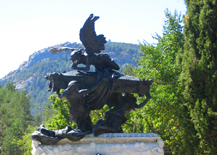
Locality: RONCAL (31415)
Address: Cementerio de Roncal
Zone: The Pyrenees
Style: Modern
Centuries of construction: XIX
Tel.: 948475180
Location
The Julián Gayarre Mausoleum is in Roncal, a Pyrenean town 88 kilometres from Pamplona. This sculpted construction takes us back to the glorious era of the Navarrese tenor and the sculptor from Valencia who created it, Mariano Benlliure.
History
The mausoleum was exhibited at the Universal Exposition in Paris in 1900 where it won the Medal of Honour for Sculpture. It is hardly surprising that the then Queen Regent, María Cristina, wanted to install it next to the Royal Theatre in Madrid, but the tenor’s family refused and it is now the star attraction of Roncal’s small cemetery, eight hundred metres from the town in which the great Gayarre was born.
Description
An essential visit in Roncal is the Mausoleum where the remains of tenor Julián Gayarre lie. The road leaves from the Town Hall, passing the spacious open-air fronton court and the schools -both gifts to the townsfolk from the tenor- taking you to the town’s peaceful cemetery in which the restored mausoleum stands out, less than one kilometre from the centre.
The sculpture, designed by the prestigious artist Mariano Benlliure from Valencia, was installed in the cemetery of the Pyrenean town in 1901, eleven years after the tenor’s death. The funerary monument, built from white and bronze marble, rises up in four levels and consists of a marble sarcophagus embellished on the façades by children, in very plain relief, singing librettos from the most famous operas performed by Gayarre.
On one side of the tomb is a female figure in bronze reclining in an abandoned pose with a lute, hiding her heartbroken face in a clear allusion to Music. The symbolic force of the mausoleum is completed by two more bronze figures; Harmony and Melody, who are balanced unsteadily on the slab of the tomb, holding up the bronze coffin in their hands. On top of the coffin, the figure of Fame leans over, as if wanting to hear the last notes from the tenor’s voice, now silenced for ever.
The cemetery in Roncal is usually closed to visitors, but a visit to the mausoleum from the outside is well worth it.
From Roncal you can visit other towns in the valley such as Isaba and Burgui, with its Rafters’ Museum, and the cheese-making dairies of Burgui, Vidángoz and Ustárroz. Another alternative is to climb up the highest peaks of Navarre in Belagua or practice cross-country and backcountry skiing in winter.







